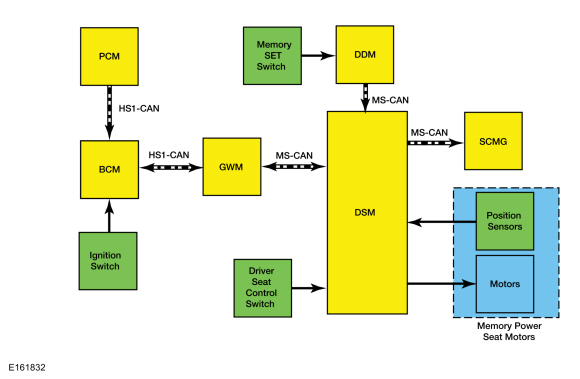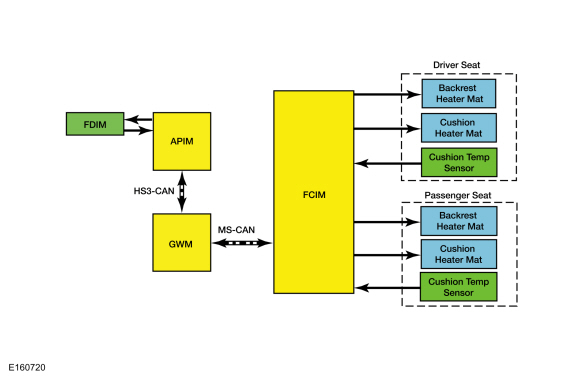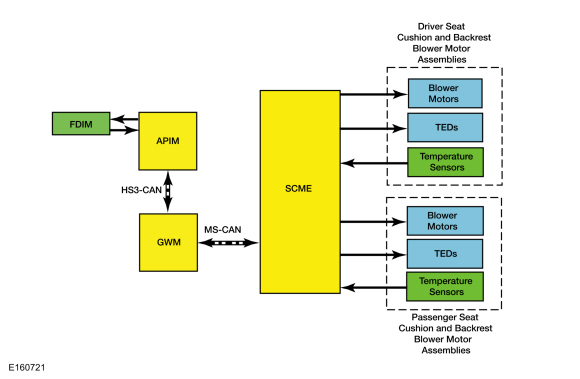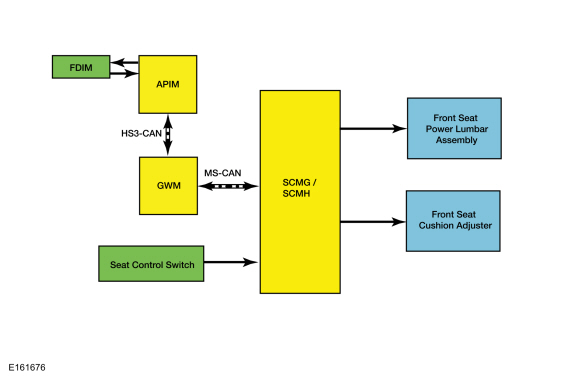| 501-10A Front Seats | 2013 - 2014 MKZ |
| Description and Operation | Procedure revision date: 07/17/2013 |
System Operation
System Diagram - Memory Seat

Network Message Chart - Memory Seat
DSM Network Input Messages
| Broadcast Message | Originating Module | Message Purpose |
|---|---|---|
| Key-in-ignition status | BCM | Provides the ignition status. This input is used for the easy entry/exit feature. |
| Personality recall | BCM | When the personality recall command is received from the BCM , the DSM stores or recalls the associated memory seat position (1, 2 or 3). If a RKE transmitter has been programmed to a memory position, this input is used to recall the associated memory seat position. |
| Memory seat switch status | DDM | When the memory set switch (1, 2 or 3) is activated, the DDM sends this message to the DSM , which then stores or recalls the associated memory seat position. |
SCMG Network Input Messages
| Broadcast Message | Originating Module | Message Purpose |
|---|---|---|
| Easy entry/exit | DSM | This input is used for the easy entry/exit feature. |
| Seat memory command | DSM | When the personality recall command is received from the DSM , the SCMG stores or recalls the associated memory seat bladder pressures and multi-contour adjust/massage setting for personality (1, 2 or 3). If a RKE transmitter has been programmed to a memory position, this input is used to recall the associated memory seat settings. |
System Diagram - Heated Seats

Network Message Chart - Heated Seats
FCIM Network Input Messages
| Broadcast Message | Originating Module | Message Purpose |
|---|---|---|
| Climate control requests | FDIM | The climate control requests message contains the heated seat request information. |
FDIM Network Input Messages
| Broadcast Message | Originating Module | Message Purpose |
|---|---|---|
| Climate control button status | FCIM | The FCIM provides this message to the FDIM for the purpose of updating the displayed status of the heated seat buttons on the FDIM (touchscreen). |
System Diagram - Climate Controlled Seats

Network Message Chart - Climate Controlled Seats
SCME Network Input Messages
| Broadcast Message | Originating Module | Message Purpose |
|---|---|---|
| Climate control requests | FDIM | The climate control requests message contains the climate controlled seat request information. |
FDIM Network Input Messages
| Broadcast Message | Originating Module | Message Purpose |
|---|---|---|
| Climate control button status | SCME | The SCME provides this message to the FDIM for the purpose of updating the displayed status of the climate controlled seat buttons on the FDIM (touchscreen). |
System Diagram - Multi-Contour Front Seats

Network Message Chart - Multi-Contour Front Seats
FDIM Network Input Messages
| Broadcast Message | Originating Module | Message Purpose |
|---|---|---|
| Multi-contour seat switch status | SCMG / SCMH | The SCMG / SCMH provide this message to the FDIM for the purpose of updating the displayed status of the multi-contour seat buttons on the FDIM (touchscreen). |
| Driver/passenger multi-contour seat position data | SCMG / SCMH | The SCMG and SCMH provide this message to the FDIM for the purpose of updating the displayed pressure of the multi-contour seat bladders and bolster pairs on the FDIM (touchscreen). |
SCMG / SCMH Network Input Messages
| Broadcast Message | Originating Module | Message Purpose |
|---|---|---|
| Multi-contour seat request | FDIM | The multi-contour seat request message contains the requested multi-contour function(s) from the touchscreen. |
Memory Seat Operation
The driver seat control switch provides a voltage signal to the DSM only when activated. This voltage signal causes the DSM to power the appropriate motor until the input is removed. The motor circuits are normally grounded through the DSM . The DSM internally switches the appropriate circuit from ground to voltage to operate the motors.
As the seat is adjusted, the DSM monitors the motor position sensors to record the current seat position. The DSM removes voltage from the motor upon termination of the seat control switch input or if the DSM does not detect movement from the motor while monitoring the position sensor during a memory recall operation.
If the DSM loses the signal from any of motor position sensors, the affected seat motor will operate in jog mode. Jog mode allows limited operation of the affected seat motor using only the seat control switch. When the seat control switch is operated in jog mode, the seat moves in the desired direction for one second, then stops. The seat control switch must be released, then pressed again in order to move the seat for an additional second. Jog mode is an indication that there is a seat motor sensor fault. If the memory seat is operating in jog mode, a DTC sets in the DSM .
If equipped with multi-contour seats, the SCMG will store or recall the target pressures for the lumbar and bolster in manual adjust mode, as well as the massage mode and intensity, whenever the personality command is received from the DSM .
DSM Hard Stop/Soft Stop
The DSM has the ability for soft stops both at the upper and lower limits on all axes of the driver seat. When an axis reaches the hard stop and the switch is held for approximately one second, it then backs up 180 ms and establishes the soft stop for that axis in that direction. The DSM uses this back up strategy to check sensor integrity any time movement has stopped prematurely due to a sensor failure or obstruction.
A hard stop occurs when one of the memory seat track axes or backrest recline physically reach the end of travel and can go no further. A soft stop occurs when the seat stops before physically reaching the end of travel. The hard stop is set by seat design and cannot be changed or adjusted. The soft stop is set by the DSM . The seat track axes are forward/rearward, front up/down and rear up/down. The backrest axis is recline forward/backward. To prevent unnecessary stress on the seat and motors, the DSM sets soft stop positions, 2 for each moving axis. The DSM uses a preset distance from the hard stop to determine where the soft stop occurs. When an axis reaches the hard stop and the switch is held for approximately one second, the DSM establishes the soft stop for that axis in that direction.
Easy Entry/Exit
The easy entry/exit feature is a function of the DSM that moves the driver seat back approximately 50.8 mm (2 in) (unless seat is already positioned at or near the end of travel) when the ignition is turned off. The DSM receives a key-in-ignition status over the Medium Speed Controller Area Network (MS-CAN) and operates the driver seat rearward. The DSM cancels this operation if a valid input command is received from the driver seat control switch, memory set switch, exterior mirror control switch or if the function has been disabled.
The DSM records the current seat positions before operating the seat for an easy exit operation. During easy entry operation (when the ignition is turned on), the seat is returned to the recorded seat position previous to the easy exit operation. Easy entry operation is cancelled if a valid input command is received by the DSM . A memory position recall using the memory set switch also overrides the easy exit operation.
The easy entry/exit feature can be enabled/disabled on the message center. For information on programming vehicle settings in the message center, refer to the Owner's Literature.
Heated Seat Operation
The driver and passenger heated seat buttons are selected from the FDIM (touchscreen). The FDIM is mounted directly to the APIM . The heated seat system functions independently of the vehicle's climate control system. Each time the heated seat button is pressed, the APIM sends the request to the GWM using the High Speed Controller Area Network 3 (HS3-CAN). The GWM sends the message to the FCIM which decreases one setting (the sequence is high, low, off, high, etc.).
When activated, the FCIM supplies voltage to the selected seat heater circuit. Each seat cushion heater mat and backrest heater mat is connected in a series circuit to the FCIM and powered by the output circuit for that seat. The FCIM monitors inputs from a temperature sensor located in each seat cushion heater mat, and maintains seat temperature by cycling the heater circuits on/off. The heated seat remains ON until the heated seat switch button is pressed to cycle the FCIM OFF or the ignition is set to OFF.
If a fault is detected by the FCIM , the module stops supplying voltage to that individual left or right seat that the fault was detected on until the ignition is turned OFF and then ON.
Climate Controlled Seat Operation
The driver and passenger climate controlled seat buttons are selected from the FDIM (touchscreen). The FDIM is mounted directly to the APIM . The climate controlled seat system functions independently of the vehicle's climate control system. When the climate controlled seat buttons are pressed, the APIM sends the request to the GWM using the High Speed Controller Area Network 3 (HS3-CAN). The GWM sends the message to the SCME .
The seat cushion and backrest are each equipped with a blower motor assembly. As cabin air is drawn through each blower motor, the blower motors heat or cool the air, which is then directed into the foam pad where it is distributed along the surface of the cushion and backrest of the seat. Once the system is activated, the SCME uses a set of flexible algorithms to control the heating/cooling modes and the blower speed dependant on the commanded climate controlled seat settings.
The SCME monitors seat cushion temperature while it supplies voltage and ground to both blower motors. The SCME also supplies a variable voltage signal to control the blower speed. Cabin air enters the blower through a filter attached to the blower motor housing. Heated or cooled air exits the blower motor and flows through the foam pad.
Climate Controlled Seat Heating Characteristics
Climate Controlled Seat Cooling Characteristics
Climate Controlled Seat Recovery Mode
NOTE: The presence of overtemperature faults (Diagnostic Trouble Codes (DTCs) B2729, B2730, B272A and B272B) can be induced by incorrectly operating the climate controlled seat system after an initial heat setting has been attained. If a heat setting is repeatedly turned off and on in an attempt to increase the seat temperature or repeatedly toggled between heat and cool modes, an overtemperature condition can result and the Diagnostic Trouble Codes (DTCs) may be set.
If the temperature of one of the blower motors rises above 110° C (229.8° F) in the heat mode or 65° C (148.9° F) in the cool mode for more than 4 seconds, the SCME records an overtemperature DTC , removes voltage from the Thermo-Electric Devices (TEDs) (part of the blower motor assembly) and goes into recovery mode (blower only) for 30 seconds to cool down the blower motor. The same occurs if a temperature difference of 60° C (108° F) or greater is detected between the backrest and cushion blower motors on either front seat. The SCME continues to monitor the blower motors while in recovery mode. If the temperature of the Thermo-Electric Devices (TEDs) do not drop to 105° C (220.8° F) in the heat mode or 60° C (139.9° F) in the cool mode after 30 seconds, the system continues to cool the blower motors in recovery mode for up to 5 minutes. If the Thermo-Electric Devices (TEDs) cool down after 30 seconds, but before 5 minutes (checked at 4 second intervals), the system is operating normally. An overtemperature DTC is still recorded even if the system recovers and is operating normally. This is more likely to occur during extreme cabin temperatures with significant seat back sun load. If the system does not recover within 30 seconds in heat mode or within 5 minutes in cool mode, the SCME disables that seat (fault mode) and remains off until the ignition is cycled. Also, if the SCME detects a temperature differential fault twice during the same ignition cycle, the SCME disables the seat. When a fault causes a shutdown, the climate controlled seat indicators turn off and that seat is not operational until the next ignition cycle.
Multi-Contour Seat Operation
The multi-contour seats are independently controlled by the seat control switches (located on the outer side of the front seat cushions) or the FDIM (touchscreen). The driver and passenger front seats each contain a total of 11 inflatable bladders: 4 cushion bladders, 2 cushion side bolsters, 3 backrest lumbar bladders and 2 backrest side bolsters. The pressures for the lumbar bladders, cushion bolster pair and backrest bolster pair are displayed on the FDIM as a percentage of the maximum pressure.
There are 2 modes of operation: adjust or massage. Adjust mode allows pressure changes in one of the 3 lumbar bladders and 2 sets of bolsters to be inflated or deflated to a desirable feel. Massage mode provides a sequence of inflation and deflation of the lumbar and cushion bladders to simulate a massage motion. When the massage mode is active, it will turn off (time-out) after 20 minutes of operation.
NOTE: Refer to the Owner's Literature for information how to select the various modes using the seat control switch or touchscreen buttons.
When in Adjust mode:
When in Massage mode:
Each multi-contour seat can be restored to the original factory settings by pressing and holding the select button greater than 30 seconds. This resets all the adjust and massage settings (including any multi-contour driver seat settings associated to memory personality 1, 2 or 3).
Component Description
Seat Control Switch
The seat control switch is hard-wired to the DSM , which controls seat operation. When a specific seat adjustment position is selected, an individual circuit is switched to voltage.
If equipped with multi-contour seats, the seat control switch also contains a 5 position momentary contact switch which provides an analog signal (stepped resistance) to the SCMG or SCMH . The resistance range for each multi-contour button is as follows:
| Multi-Contour Switch | Resistance |
|---|---|
| Select | 26 to 54 ohms |
| Down | 113 to 125 ohms |
| Up | 196 to 221 ohms |
| Deflate | 317 to 351 ohms |
| Inflate | 483 to 533 ohms |
| No switch active | 573 to 634 ohms |
DSM
The driver seat control switch and power memory seat motors are hard-wired to the DSM . The DSM controls the operation of the power memory seat. The DSM communicates on the Medium Speed Controller Area Network (MS-CAN). PMI is required when a new DSM is installed. The DSM hard stop/soft stops must be set/reset any time a new DSM , driver seat track or driver seat backrest is installed.
Memory Set Switch
The memory set switch contains 3 momentary contact switches. It is hard-wired to the DDM and is used to recall 1 of 3 memory positions stored in the DSM .
Driver Seat Track
There are 3 front seat track bi-directional motors present on power seat tracks. The horizontal (fore/aft) front seat track motor is the only seat track motor which can be serviced separately from the seat track assembly. All other seat track motors (front height, rear height) are serviced as part of the seat track assembly. Each seat track motor contains a Hall-effect sensor which provides seat track position information to the DSM for setting/obtaining desired preset seat memory positions. The seat track motors move the power seat forward/backward and up/down depending on the polarity of voltage supplied from the DSM .
Passenger Seat Track
There are 3 front seat track bi-directional motors present on power seat tracks. The horizontal (fore/aft) front seat track motor is the only seat track motor which can be serviced separately from the seat track assembly. All other seat track motors (front height, rear height) are serviced as part of the seat track assembly. The seat track motors move the power seat forward/backward and up/down depending on the polarity of voltage supplied from the seat control switch.
Driver Seat Backrest
The driver seat backrest contains a bi-directional motor which is integral to the seat backrest frame assembly. The seat backrest motor contains a Hall-effect sensor which provides seat backrest position information to the DSM for setting/obtaining desired preset seat memory positions. The seat backrest motor moves the seat backrest forward/backward depending on the polarity of voltage supplied from the DSM .
Passenger Seat Backrest
The passenger seat backrest contains a bi-directional motor which is integral to the seat backrest frame assembly. The seat backrest motor moves the seat backrest forward/backward depending on the polarity of voltage supplied from the seat control switch.
FDIM
The FDIM (touchscreen) contains the heated seat (or climate controlled seat) and multi-contour seat control buttons.
FCIM
If equipped with heated seats, the FCIM monitors the seat cushion temperature sensor and supplies heater current to the seat cushion and backrest heater mats until the desired setpoint temperature is reached. Once the setpoint temperature is reached, the FCIM cycles the heater circuits on/off as required to maintain the setpoint temperature. PMI is required when a new FCIM is installed.
Heater Mat
If equipped with heated seats, the cushion heater mats are each equipped with a temperature sensor (thermistor) which provides feedback to the FCIM . The heater mats are serviced by installing a new backrest/cushion foam. The cushion and backrest heater mats are connected in series.
SCME
If equipped with climate controlled seats, The SCME controls the operation of the climate controlled seat system. PMI is required when a new SCME is installed.
SCMG
The SCMG controls the operation of the driver multi-contour seat. PMI is required when a new SCMG is installed. SCMG communicates on the MS-CAN . The SCMG controls the air pump (part of the front seat power lumbar assembly) which supplies air pressure necessary to be diverted to the applicable air bladders/bolsters as required for the desired mode(s) of operation.
SCMH
The SCMH controls the operation of the passenger multi-contour seat. PMI is required when a new SCMH is installed. The SCMH communicates on the MS-CAN . The SCMH controls the air pump (part of the front seat power lumbar assembly) which supplies air pressure necessary to be diverted to the applicable air bladders/bolsters as required for the desired mode(s) of operation.
Blower Motor
If equipped with climate controlled seats, the seat cushion and backrest are each equipped with a blower motor assembly that includes a seat blower (Thermo-Electric Device (TED), fan motor, serviced as an assembly). There is also a temperature sensor (thermistor) in each blower motor which provides feedback to the SCME . The blower motor assembly is controlled by the SCME .
Front Seat Power Lumbar Assembly
The front seat power lumbar assembly is mounted to the backrest (serviced as an assembly).
Front Seat Power Lumbar Assembly - Multi-Contour Seats
The front seat power lumbar assembly includes an air pump, air hoses and bladders (serviced as an assembly).
Front Seat Cushion Adjuster - Multi-Contour Seats
The front seat cushion adjuster includes air hoses and bladders (serviced as an assembly).
Copyright © Ford Motor Company